Spring03Spring的连接数据库以及JDBC模板
Posted
tags:
篇首语:本文由小常识网(cha138.com)小编为大家整理,主要介绍了Spring03Spring的连接数据库以及JDBC模板相关的知识,希望对你有一定的参考价值。
前言
今天介绍的是关于Spring的数据库连接以及Jdbc模板的相关API方法,虽然在学习了hibernate之后,会知道实现数据库连接一般都是使用hibernate等持久化框架来实现的。但是,很多时候一些涉及到事务的东西使用这些框架并不能够实现,所以我们还需要结合spring来实现相关的需要。
一、创建工程、导包
要想使用Spring的jdbc模板前,还需要导入相关的jar包:
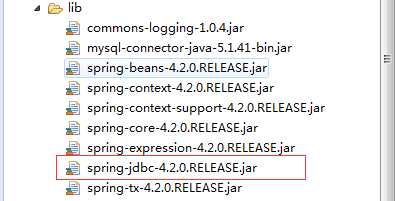
二、进行相关的bean的创建以及工具类的编写
2.1在数据库中创建了两张表,使用spring的jdbcTemplate中的API方法对这两张表进行操作
CREATE TABLE `t_dept` ( `deptid` int(11) NOT NULL, `deptname` varchar(20) CHARACTER SET utf8 DEFAULT NULL, `remark` varchar(30) CHARACTER SET utf8 DEFAULT NULL, PRIMARY KEY (`deptid`) ) ENGINE=InnoDB DEFAULT CHARSET=gbk COLLATE=gbk_bin;
CREATE TABLE `user` ( `USER_ID` int(11) NOT NULL, `USER_NAME` varchar(11) DEFAULT NULL, `USER_PASSWORD` varchar(11) DEFAULT NULL, `USER_ADDRESS` varchar(25) DEFAULT NULL, PRIMARY KEY (`USER_ID`) ) ENGINE=InnoDB DEFAULT CHARSET=utf8;
2.2创建实体bean
package com.bean; /** * 创建t_dept表对应的表 * @author 夜孤寒 * @version 1.1.1 * */ public class DeptBean { private int deptid; private String deptname; private String remark; public DeptBean() { super(); } public DeptBean(int deptid, String deptname, String remark) { super(); this.deptid = deptid; this.deptname = deptname; this.remark = remark; } public int getDeptid() { return deptid; } public void setDeptid(int deptid) { this.deptid = deptid; } public String getDeptname() { return deptname; } public void setDeptname(String deptname) { this.deptname = deptname; } public String getRemark() { return remark; } public void setRemark(String remark) { this.remark = remark; } }
2.3创建spring的工具类——SpringUtil.java
package com.util; import org.springframework.context.ApplicationContext; import org.springframework.context.support.ClassPathXmlApplicationContext; /** * 读取配置文件的工具类,实现了类似工厂模式的方式 * * @author 夜孤寒 * @version 1.1.1 */ public class SpringUtil { // 定义属性 private static ApplicationContext context; // 读取配置文件 static { context = new ClassPathXmlApplicationContext("spring.xml"); } // 定义一个方法,判断bean是否为空,如果不为空的,获取这个bean public static Object getBean(String beanName) { // 定义一个空对象 Object obj = null; // 如果beanName不为空的话,那么根据这个beanName获取到bean对象,赋值给obj并返回 if (beanName != null && !beanName.equals("")) { obj = context.getBean(beanName); } return obj; } }
2.4进行配置文件的相关配置——spring.xml文件的配置
因为要介绍的API方法可能比较多,所以一次性将写过的xml全部粘贴了,读者可以根据对应的配置,去对应到相应的类中:
<?xml version="1.0" encoding="UTF-8"?> <beans xmlns="http://www.springframework.org/schema/beans" xmlns:xsi="http://www.w3.org/2001/XMLSchema-instance" xmlns:p="http://www.springframework.org/schema/p" xmlns:context="http://www.springframework.org/schema/context" xmlns:aop="http://www.springframework.org/schema/aop" xmlns:tx="http://www.springframework.org/schema/tx" xsi:schemaLocation="http://www.springframework.org/schema/beans http://www.springframework.org/schema/beans/spring-beans-3.0.xsd http://www.springframework.org/schema/context http://www.springframework.org/schema/context/spring-context-3.0.xsd http://www.springframework.org/schema/tx http://www.springframework.org/schema/tx/spring-tx-3.0.xsd http://www.springframework.org/schema/aop http://www.springframework.org/schema/aop/spring-aop-3.0.xsd"> <!-- 方式一: 配置使用IOC:直接引用 --> <!-- 首先需要引入一个驱动,然後到這驱动类下面,去查看他的源代码,一下是mysql需要注入的对象 --> <bean name="dataSource" class="org.springframework.jdbc.datasource.DriverManagerDataSource"> <property name="driverClassName" value="com.mysql.jdbc.Driver"></property> <property name="url" value="jdbc:mysql://localhost:3306/spring_jdbc_test"></property> <property name="username" value="root"></property> <property name="password" value="root"></property> </bean> <!-- 使用DI注入的构造方法注入的方式来注入,并且查询我们的数据库中的数据。 注意这里我们还需要一我们之前的dataSource作为引用 --> <bean name="testMain_2" class="com.jdbc.TestMain_2"> <property name="dataSource" ref="dataSource"></property> </bean> <!-- 使用我们的模板来获取我们的数据库中的数据 --> <bean name="testMain_3" class="com.jdbc.TestMain_3"> <!-- 首先我们还是需要引入我们的数据库资源,也就是我们之前已经配置过的dataSource --> <property name="dataSource" ref="dataSource"></property> </bean> <!-- 方式四 --> <!-- 配置我们模板,然后在类就只要将这个模板用构造方法的方式注入就可以了 --> <bean name="jdbcTemplate" class="org.springframework.jdbc.core.JdbcTemplate"> <property name="dataSource" ref="dataSource"></property> </bean> <!-- 配置我们的testMain_4,然后引用我们上面配置的模板 --> <bean name="testMain_4" class="com.jdbc.TestMain_4"> <property name="jdbcTemplate" ref="jdbcTemplate"></property> </bean> <!-- 方式五: 直接继承JdbcDaoSupport这个父类,然后用里面的方法获取到模板, 从而获取到数据。 备注:这个是最完美的获取数据的方式,以后一般都是使用这种方式!!! --> <bean name="testMain_5" class="com.jdbc.TestMain_5"> <property name="dataSource" ref="dataSource"></property> </bean> <!-- 使用spring配置的方式操作我们的DDL语句 --> <bean name="testMain_6" class="com.jdbc.TestMain_6"> <property name="dataSource" ref="dataSource"></property> </bean> <!-- 使用spring配置的方式操作我们的DML语句 --> <bean name="testMain_7" class="com.jdbc.TestMain_7"> <property name="dataSource" ref="dataSource"></property> </bean> <!-- 使用JdbcTemplate模板中的命名参数来操作我们的DML语句 --> <bean name="testMain_8" class="com.jdbc.TestMain_8"> <property name="dataSource" ref="dataSource"></property> </bean> <!-- 使用JdbcTemplate模板对于查询语句的封装 --> <bean name="testMain_9" class="com.jdbc.TestMain_9"> <property name="dataSource" ref="dataSource"></property> </bean> </beans>
2.5介绍spring对于jdbc的模板的支持
(1)数据库的连接
对应xml中的配置为:
<!-- 方式一: 配置使用IOC:直接引用 --> <!-- 首先需要引入一个驱动,然後到這驱动类下面,去查看他的源代码,一下是mysql需要注入的对象 --> <bean name="dataSource" class="org.springframework.jdbc.datasource.DriverManagerDataSource"> <property name="driverClassName" value="com.mysql.jdbc.Driver"></property> <property name="url" value="jdbc:mysql://localhost:3306/spring_jdbc_test"></property> <property name="username" value="root"></property> <property name="password" value="root"></property> </bean>
对应的测试类:
package com.jdbc; import java.sql.Connection; import java.sql.SQLException; import javax.sql.DataSource; import com.util.SpringUtil; /** * 连接数据库的测试类 * @author 夜孤寒 * @version 1.1.1 * */ public class TestMain_1 { public static void main(String[] args) { /* * 本来需要用applicationContext获取到我们的bean对象, * 这里使用工厂类的方法将之独立出来,具体使用见SpringUtil.java */ DataSource datasource=(DataSource)SpringUtil.getBean("dataSource"); Connection conn=null; try{ conn=datasource.getConnection(); }catch(SQLException e){ e.printStackTrace(); } System.out.println(conn);//测试是否能够输出连接 } }
测试结果:

由此可见测试成功可以获取到相应的数据库连接。
(2)测试从创建的user表中查询出相应的数据
对应xml配置为:
<!-- 使用DI注入的构造方法注入的方式来注入,并且查询我们的数据库中的数据。 注意这里我们还需要一我们之前的dataSource作为引用 --> <bean name="testMain_2" class="com.jdbc.TestMain_2"> <property name="dataSource" ref="dataSource"></property> </bean>
对应的测试类为:
package com.jdbc; import java.sql.Connection; import java.sql.ResultSet; import javax.sql.DataSource; import com.mysql.jdbc.Statement; import com.util.SpringUtil; /** * 从创建的user表中查询相关的数据 * * @author 夜孤寒 * @version 1.1.1 */ public class TestMain_2 { // 使用构造方法注入 public DataSource datasource; public void setDataSource(DataSource datasource) { this.datasource = datasource; } /** * 从user表中获取所有数据 */ public void list() { /* * 在我们的main方法中获取到我们的datasource, 然后就能够获取连接,并且获取到数据库中的数据。 */ Connection conn = null; Statement stmt = null; ResultSet rs = null; String sql = "select * from user"; try { conn = datasource.getConnection(); stmt = (Statement) conn.createStatement(); rs = stmt.executeQuery(sql); while (rs.next()) { System.out.println(rs.getInt("user_id") + "\\t" + rs.getString("user_name") + "\\t" + rs.getString("user_password") + "\\t" + rs.getString("user_address")); } } catch (Exception e) { e.printStackTrace(); } finally { /* * 需要自己关闭资源 */ } } public static void main(String[] args) { // 获取到我们bean对象 TestMain_2 testMain_2 = (TestMain_2) SpringUtil.getBean("testMain_2"); // 调用我们的list方法 testMain_2.list(); } }
测试结果:
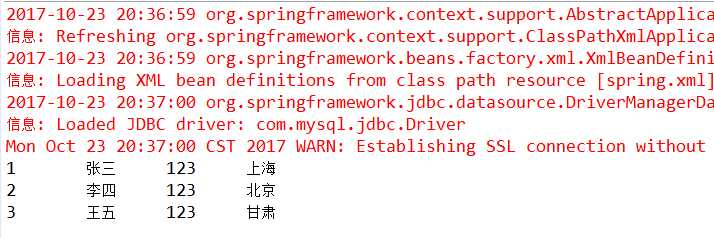
备注:本测试类,使用的是常用的纯粹的jdbc获取数据的方式。
(3)使用JdbcTemplate这个类来获取到后端的数据
对应的xml文件的配置为:
<!-- 使用我们的模板来获取我们的数据库中的数据 --> <bean name="testMain_3" class="com.jdbc.TestMain_3"> <!-- 首先我们还是需要引入我们的数据库资源,也就是我们之前已经配置过的dataSource --> <property name="dataSource" ref="dataSource"></property> </bean>
对应的测试类:
package com.jdbc; import java.util.List; import java.util.Map; import javax.sql.DataSource; import org.springframework.jdbc.core.JdbcTemplate; import com.util.SpringUtil; /** * 使用jdbcTemplate这个类来获取后台数据 * @author 夜孤寒 * */ public class TestMain_3 { // 使用构造方法注入 public DataSource datasource; public void setDataSource(DataSource datasource) { this.datasource = datasource; } public void list() { /* * 使用我们JdbcTemplate模板来获取我们的数据 */ JdbcTemplate jdbcTemplate=new JdbcTemplate(this.datasource); String sql="select * from user"; List<Map<String, Object>>userlist=jdbcTemplate.queryForList(sql); for(Map<String, Object>rowMap:userlist){ System.out.println(rowMap); } } public static void main(String[] args) { //获取到我们bean对象 TestMain_3 testMain_3=(TestMain_3)SpringUtil.getBean("testMain_3"); //调用我们的list方法 testMain_3.list(); } }
测试的结果:
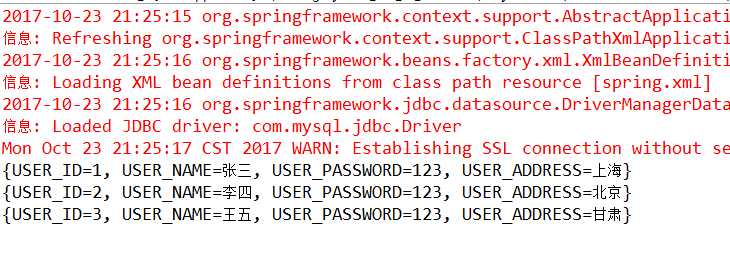
这种方式的话每次我们都要创建一个JdbcTemplate实例,这样子比较复杂,所以考虑能不能将这个类让Spring自己创建,然后在bean配置文件中引用数据源来达到目的。这就是下面要介绍的第四种方式。
(4)在配置文件中配置我们的模板类,让Spring生成需要的bean
对应的xml配置文件为:
<!-- 方式四 --> <!-- 配置我们模板,然后在类就只要将这个模板用构造方法的方式注入就可以了 --> <bean name="jdbcTemplate" class="org.springframework.jdbc.core.JdbcTemplate"> <property name="dataSource" ref="dataSource"></property> </bean> <!-- 配置我们的testMain_4,然后引用我们上面配置的模板 --> <bean name="testMain_4" class="com.jdbc.TestMain_4"> <property name="jdbcTemplate" ref="jdbcTemplate"></property> </bean>
对应的测试类为:
package com.jdbc; import java.util.List; import java.util.Map; import org.springframework.jdbc.core.JdbcTemplate; import com.util.SpringUtil; /** * 在配置文件中配置模板,让spring去创建模板类 * * @author 夜孤寒 * @version 1.1.1 */ public class TestMain_4 { // 使用构造方法的方式注入template public JdbcTemplate jdbcTemplate; public void setJdbcTemplate(JdbcTemplate jdbcTemplate) { this.jdbcTemplate = jdbcTemplate; } public void list() { /* * 使用我们IOC注入模板,然后引用这个使用IOC注入的模板, 最后取出我们的数据 */ String sql = "select USER_NAME from user"; List<Map<String, Object>> userlist = this.jdbcTemplate.queryForList(sql); for (Map<String, Object> rowMap : userlist) { System.out.println(rowMap); } } public static void main(String[] args) { // 获取到我们bean对象 TestMain_4 testMain_4 = (TestMain_4) SpringUtil.getBean("testMain_4"); // 调用我们的list方法 testMain_4.list(); } }
测试结果:
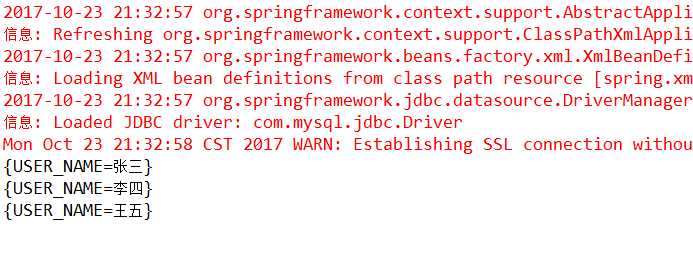
这种方式仍旧需要在xml中配置,而在spring中还有一种更加方便的方式就是直接继承JdbcDaoSupport这个类,这种方式是最简单的,也是最常用的方式。下面笔者就简单介绍一下这种方式的使用。
(5)继承JdbcDaoSupport类来获取数据库中的数据
对应的xml文件中的配置为:
<!-- 方式五: 直接继承JdbcDaoSupport这个父类,然后用里面的方法获取到模板, 从而获取到数据。 备注:这个是最完美的获取数据的方式,以后一般都是使用这种方式!!! --> <bean name="testMain_5" class="com.jdbc.TestMain_5"> <property name="dataSource" ref="dataSource"></property> </bean>
对应的测试类为:
package com.jdbc; import java.util.List; import java.util.Map; import org.springframework.jdbc.core.support.JdbcDaoSupport; import com.util.SpringUtil; /** * 继承JdbcDaoSupport来获取模板,再通过模板来获取数据 * @author 夜孤寒 * @version 1.1.1 * */ public class TestMain_5 extends JdbcDaoSupport { /* * 不使用DI注入的方式,直接继承一个上述的父类, 观察上述的父类,发现在这个父类里面已经实现了类似注入JdbcTemplate模板。 */ public void list() { String sql = "select * from user"; List<Map<String, Object>> userlist = this.getJdbcTemplate().queryForList(sql); for (Map<String, Object> rowMap : userlist) { System.out.println(rowMap); } } public static void main(String[] args) { // 获取到我们bean对象 TestMain_5 testMain_5 = (TestMain_5) SpringUtil.getBean("testMain_5"); // 调用我们的list方法 testMain_5.list(); } }
测试结果为:
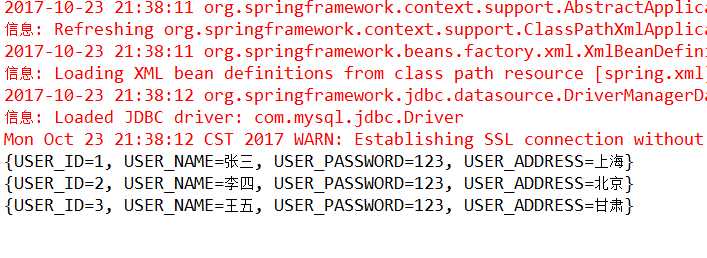
(6)使用Spring注入的方式来操作DDL语句
对应xml文件中的配置为:
<!-- 使用spring配置的方式操作我们的DDL语句 --> <bean name="testMain_6" class="com.jdbc.TestMain_6"> <property name="dataSource" ref="dataSource"></property> </bean>
对应的测试类为:
package com.jdbc; import org.springframework.jdbc.core.support.JdbcDaoSupport; import com.util.SpringUtil; /** * 使用spring注入的方式进行DDL操作 * * @author 夜孤寒 * @version 1.1.1 * */ public class TestMain_6 extends JdbcDaoSupport { /* * 创建表 */ public void create() { StringBuffer createSQL = new StringBuffer(); createSQL.append("create table T_Temp_XX(id int,testname varchar(30))"); this.getJdbcTemplate().execute(createSQL.toString()); } /* * 修改表,这里面可以添加或者删除某一个属性列 */ public void alter() { StringBuffer alterSQL = new StringBuffer(); alterSQL.append("alter table T_Temp_XX add testpassword varchar(30)"); this.getJdbcTemplate().execute(alterSQL.toString()); } /* * 删除一张表 */ public void drop() { StringBuffer dropSQL = new StringBuffer(); dropSQL.append("drop table T_Temp_XX"); this.getJdbcTemplate().execute(dropSQL.toString()); } /* * 测试方法 */ public static void main(String[] args) { // 获取到我们bean对象 TestMain_6 testMain_6 = (TestMain_6) SpringUtil.getBean("testMain_6"); // 调用我们的方法,一次调用一个方法,打开数据库观察数据库是不是已经变化了 // testMain_6.create(); // testMain_6.alter(); testMain_6.drop(); } }
经过测试可以进行DDL操作。
(7)使用spring注入的方式进行DML操作
对应xml文件中的配置:
<!-- 使用spring配置的方式操作我们的DML语句 --> <bean name="testMain_7" class="com.jdbc.TestMain_7"> <property name="dataSource" ref="dataSource"></property> </bean>
对应测试类:
package com.jdbc; import java.sql.PreparedStatement; import java.sql.SQLException; import org.springframework.jdbc.core.PreparedStatementSetter; import org.springframework.jdbc.core.support.JdbcDaoSupport; import com.util.SpringUtil; /** * 使用spring配置的方式操作我们的DML语句 * * @author 夜孤寒 * @version 1.1.1 */ public class TestMain_7 extends JdbcDaoSupport { /* * statement的写法 */ public void insert() { int deptid = 1; String deptname = "zhangsan"; String remark = "zhangsanzhenshuai"; StringBuffer insertSQL = new StringBuffer(); insertSQL.append("Insert Into T_Dept("); insertSQL.append("deptid,deptname"); insertSQL.append(",remark"); insertSQL.append(") values("); insertSQL.append("" + deptid + ","); insertSQL.append("‘" + deptname + "‘,"); insertSQL.append("‘" + remark + "‘"); insertSQL.append(""); insertSQL.append(")"); int rowCount = this.getJdbcTemplate().update(insertSQL.toString()); System.out.println("rowCount影响的行数= " + rowCount); } /* * prepareStatement的写法 */ public void update() { StringBuffer updateSQL = new StringBuffer(); updateSQL.append("update t_dept set "); updateSQL.append("deptname = ?,"); updateSQL.append("remark = ?"); updateSQL.append(" where deptid=?"); int rowCount = this.getJdbcTemplate().update(updateSQL.toString(), new PreparedStatementSetter() { @Override public void setValues(PreparedStatement ps) throws SQLException { ps.setString(1, "lisi"); ps.setString(2, "lisizhenshuai"); ps.setInt(3, 1); } }); System.out.println("rowCount影响的行数=" + rowCount); } /* * prepareStatement的写法 */ public void delete() { StringBuffer deleteSQL = new StringBuffer(); deleteSQL.append("delete from t_dept"); deleteSQL.append(" where deptid=?"); /* * 关于对象数组的使用:对象数组的第一个元素对应的是SQL语句中的第一个参数问号 */ Object[] obj = { 1 }; int rowCount = this.getJdbcTemplate().update(deleteSQL.toString(), obj); System.out.println("rowCount影响的行数=" + rowCount); } public static void main(String[] args) { // 获取到bean对象 TestMain_7 testMain_7 = (TestMain_7) SpringUtil.getBean("testMain_7"); // 测试方法 // testMain_7.insert(); // testMain_7.update(); testMain_7.delete(); } }
经测试,可以实现DML操作中的增删改查。
(8)使用JdbcTemplate模板中的命名参数来操作我们的DML语句
对应xml中的配置为:
<!-- 使用JdbcTemplate模板中的命名参数来操作我们的DML语句 --> <bean name="testMain_8" class="com.jdbc.TestMain_8"> <property name="dataSource" ref="dataSource"></property> </bean>
对应的测试类:
package com.jdbc; import java.util.HashMap; import java.util.Map; import org.springframework.jdbc.core.namedparam.BeanPropertySqlParameterSource; import org.springframework.jdbc.core.namedparam.NamedParameterJdbcDaoSupport; import org.springframework.jdbc.core.namedparam.NamedParameterJdbcTemplate; import com.bean.DeptBean; import com.util.SpringUtil; /** * 使用JdbcTemplate模板中的命名参数来操作我们的DML语句 * * @author 夜孤寒 * @version 1.1.1 */ public class TestMain_8 extends NamedParameterJdbcDaoSupport { /* * statement的写法 */ public void insert(boolean flag_1, boolean flag_2) { int deptid = 1; String deptname = "zhangsan"; String remark = "zhangsanzhenshuai"; StringBuffer insertSQL = new StringBuffer(); insertSQL.append("insert into T_Dept(deptid"); if (flag_1) { insertSQL.append(",deptname"); } if (flag_2 == true) { insertSQL.append(",remark"); } insertSQL.append(") values("); insertSQL.append(":deptid"); if (flag_1 == true) { insertSQL.append(",:deptname"); } if (flag_2 == true) { insertSQL.append(",:remark"); } insertSQL.append(")"); // 将数据放进我们的map中 备注:map中key的名称==命名参数的名称 Map<String, Object> paramMap = new HashMap<String, Object>(); paramMap.put("deptid", deptid); paramMap.put("deptname", deptname); paramMap.put("remark", remark); int rowCount = this.getNamedParameterJdbcTemplate().update(insertSQL.toString(), paramMap); System.out.println("rowCount影响的行数= " + rowCount); } /* * prepareStatement的写法 */ public void update() { StringBuffer updateSQL = new StringBuffer(); updateSQL.append("update T_Dept set"); updateSQL.append(" deptname = :deptname,"); updateSQL.append(" remark = :remark"); updateSQL.append(" where deptid = :deptid"); updateSQL.append(""); // 获取到模板 NamedParameterJdbcTemplate template = this.getNamedParameterJdbcTemplate(); // 将数据放置到bean里面去 DeptBean deptbean = new DeptBean(); deptbean.setDeptid(1); deptbean.setDeptname("lisi"); deptbean.setRemark("lisizhenshuai"); // 使用一个bean工厂的方法将预处理我们的bean BeanPropertySqlParameterSource paramSource = new BeanPropertySqlParameterSource(deptbean); // 调用模板方法更新数据 int rowCount = template.update(updateSQL.toString(), paramSource); // 输出影响的行数 System.out.println("影响的行数rowCount=" + rowCount); } public static void main(String[] args) { // 获取到bean对象 TestMain_8 testMain_8 = (TestMain_8) SpringUtil.getBean("testMain_8"); // 测试方法 // testMain_8.insert(true,true);//由这个参数来控制是不是插入某一个属性列的数据 testMain_8.update(); } }
(9)JdbcTemplate模板对于查询语句的封装
对应的xml文件的配置:
<!-- 使用JdbcTemplate模板对于查询语句的封装 --> <bean name="testMain_9" class="com.jdbc.TestMain_9"> <property name="dataSource" ref="dataSource"></property> </bean>
对应的测试类:
package com.jdbc; import java.sql.PreparedStatement; import java.sql.ResultSet; import java.sql.SQLException; import java.util.List; import java.util.Map; import java.util.Vector; import org.springframework.jdbc.core.BeanPropertyRowMapper; import org.springframework.jdbc.core.ColumnMapRowMapper; import org.springframework.jdbc.core.PreparedStatementSetter; import org.springframework.jdbc.core.RowMapper; import org.springframework.jdbc.core.namedparam.BeanPropertySqlParameterSource; import org.springframework.jdbc.core.namedparam.NamedParameterJdbcTemplate; import org.springframework.jdbc.core.support.JdbcDaoSupport; import com.bean.DeptBean; import com.util.SpringUtil; /** * JdbcTemplate模板对于查询语句的封装测试类 * @author 夜孤寒 * @version 1.1.1 */ public class TestMain_9 extends JdbcDaoSupport{ /* * 最简单的一个查询 */ public void one(){ System.out.println("=============================="); System.out.println("1:返回所有的对象"); String sql="select * from t_dept order by deptid asc"; List<Map<String, Object>>deptList=this.getJdbcTemplate().queryForList(sql); for(Map<String, Object>rowMap:deptList){ System.out.println(rowMap); } System.out.println("=============================="); System.out.println("2:返回一条对象"); /* * 返回一条对象,将返回的对象使用Map的方式来接收 */ sql="select * from t_dept where deptid=1"; Map<String, Object>rowMap=this.getJdbcTemplate().queryForMap(sql); if(rowMap!=null){ System.out.println(rowMap); } /* * 使用queryForObject方法来接收一个对象: * 1、如果方法的第二个参数是class类型的话,表示SQL只能返回一行一列。相当于RowMapper中的SingleColumnRowMapper; * 2、如果方法的第二个参数是rowMapper类型的话,表示SQL语句只能返回一行多列。 * 一行多列,默认是返回queryForMap,但是Spring允许可以对返回的行数据进行自定义的映射 */ /* * 方式一:返回的class类型 */ sql="select count(1) from t_dept where deptid=1";//什么意思? Integer dept_count=this.getJdbcTemplate().queryForObject(sql, Integer.class); System.out.println("dept_count="+dept_count); /* * 方式二:返回的是rowMapper的类型 */ sql="select * from t_dept where deptid=1"; BeanPropertyRowMapper<DeptBean>rowMapper=new BeanPropertyRowMapper<DeptBean>(DeptBean.class); //需要将返回的数据转换成bean对象 DeptBean deptbean=this.getJdbcTemplate().queryForObject(sql, rowMapper); System.out.println(deptbean.getDeptid()+"\\t"+deptbean.getDeptname()+"\\t"+deptbean.getRemark()); System.out.println("=============================="); } /* * 复杂的查询queryForXX: * 这个是模板封装好的查询方法 */ @SuppressWarnings({ "unchecked", "rawtypes" }) public void two(){ //1、处理有预编译的语句 String sql="select * from t_dept where deptname like ? order by deptid asc"; List<Map<String, Object>>deptList=this.getJdbcTemplate().query(sql, new PreparedStatementSetter() { @Override public void setValues(PreparedStatement ps) throws SQLException { //查询带有"l"这个字符的所有对象 ps.setString(1, "%l%"); } },new ColumnMapRowMapper());//这里代表返回的是一个什么类型 System.out.println(deptList); //2、处理带有预编译的语句,并且返回的是一个javabean List<DeptBean>deptList_2 = this.getJdbcTemplate().query( sql, new PreparedStatementSetter() { @Override public void setValues(PreparedStatement ps) throws SQLException { ps.setString(1, "%l%"); } }, new BeanPropertyRowMapper(DeptBean.class)); System.out.println(deptList_2); //3、直接处理resultSet???????什么意思 List<Vector<String>>deptList_3=this.getJdbcTemplate().query(sql, new PreparedStatementSetter() { @Override public void setValues(PreparedStatement ps) throws SQLException { ps.setString(1, "%l%"); } },new RowMapper() { @Override public Object mapRow(ResultSet rs, int rowNum) throws SQLException { int deptid = rs.getInt("deptid"); String deptname = rs.getString("deptname"); Vector<String> vector = new Vector<String>(); vector.add(String.valueOf(deptid)); vector.add(deptname); return vector; } }); System.out.println(deptList_3); } /* * 使用命名参数的查询: * 前提是首先要实例化命名参数查询的对象 */ public void three(){//传一个bean条件,返回结果 //实例化一个对象 NamedParameterJdbcTemplate template=new NamedParameterJdbcTemplate(this.getDataSource()); //如果参数是javabean,那么返回值也就是javabean String sql="select * from t_dept where deptname like :deptname and remark like :remark"; //创建一个bean,设置好查询的条件 DeptBean parambean=new DeptBean(); parambean.setDeptname("%l%"); parambean.setRemark("%shuai%"); //将创建好的bean放到查询语句的池子里面 BeanPropertySqlParameterSource paramSource=new BeanPropertySqlParameterSource(parambean); BeanPropertyRowMapper<DeptBean> rowBean = new BeanPropertyRowMapper<DeptBean>( DeptBean.class); List<DeptBean>deptList=template.query(sql, paramSource, rowBean); for(DeptBean deptbean:deptList){ System.out.println(deptbean.getDeptname()+"\\t"+deptbean.getRemark()); } } public static void main(String[] args) { //获取到bean对象 TestMain_9 testMain_9=(TestMain_9)SpringUtil.getBean("testMain_9"); //测试方法 // testMain_9.one(); // testMain_9.two(); testMain_9.three(); } }
今日笔者就将Spring中的JdbcTemplate模板介绍到这。
以上是关于Spring03Spring的连接数据库以及JDBC模板的主要内容,如果未能解决你的问题,请参考以下文章